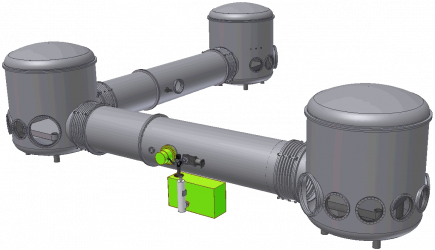One of the main noise sources limiting the peak sensitivity of current gravitational wave detectors, besides quantum noise, is the thermal noise of high reflectivity coatings on the test mass mirrors. Coating thermal noise can also limit other precision optical metrology experiments. We are building up an experiment to directly measure the coating thermal noise on sample mirrors that makes use of the existing infrastructure and sub-systems required for the sub-SQL interferometer.
What is coating thermal noise?
Mirrors used in precision experiments are composed of a high quality substrate with good optical properties such as low absorption, highly uniform refractive index, and no defects in the bulk or surfaces. One of the substrate surfaces can be made highly reflective by applying a coating consisting of alternating layers of two materials with different refractive indices. The interface between two layers generates a Fresnel reflection for incoming light. The thickness of each layer is designed so the Fresnel reflection from each interface constructively interferes with the other reflections. By adding more and more layers, the reflectivity of the mirror can reach in excess of 99.999%.
As these mirrors are used in finite temperature environments, the thermal energy from the surrounding can be absorbed by the mirrors. The fluctuation-dissipation theorem tells us that this thermal energy can couple into vibrations of the mirror. This effect can be significantly stronger for the coating compared to the mirror substrate due to at least one of the coating materials having a larger mechanical loss. The microscopically vibrating mirror surface results in effectively random length fluctuations in the interferometer arms and hence can limit the sensitivity in high precision instruments such as gravitational wave detectors. This is known as Brownian thermal noise. In addition, the thermal energy can also cause random contraction and expansion of the mirror coating, as well as fluctuation in the refractive index. These are known as coating thermo-elastic and coating thermo-refractive noise respectively.
Coating thermal noise can be reduced by:
- Using larger laser beams on the mirrors: the laser beam samples a larger area of the mirror and hence the total effective length variation of the microscopic fluctuations averages out.
- Improving the mirror: this is an active area of research with various alternatives such as engineering better coating materials (e.g. AlGaAs/GaAs crystalline coatings, which are planned to be used in the sub-SQL interferometer) or using alternative high reflectivity techniques to dielectric stacks.
- Reducing the temperature of the mirror: the next generation gravitational wave detectors are expected to operate at cryogenic temperatures to reduce the available thermal energy which can couple to the mirror.
Measuring coating thermal noise
Although coating thermal noise is a limiting noise source in gravitational wave detectors, its absolute magnitude is still extremely small (order 10-^19 m/sqrt(Hz) at 100 Hz) and challenging to directly measure in a smaller scale (table-top) experiment.
We are currently building up a thermal noise interferometer (TNI). The TNI is a two mirror Fabry-Perot cavity in a hemispherical configuration consisting of a curved input mirror and an interchangeable planar test mirror. The cavity length is 10 cm, and the laser spot size on the planar test mirror can be adjusted to small sizes to enhance the coating thermal noise. The TNI is targeting coating thermal noise measurement band between 60 Hz and 1 kHz.
All other noise sources will be suppressed below coating thermal noise by taking advantage of the existing sub-systems in the AEI 10m Prototype. Seismic noise is suppressed by using triple suspensions (the same 850 g suspensions used for the frequency reference cavity) which are installed on one of our AEI-SAS isolation tables in the vacuum system. The vacuum system also ensures good shielding from acoustic noise. Laser power noise and frequency noise is sufficiently low by sharing the pre-stabilised laser. The experiment can be controlled and read out using our digital control and data system.
The TNI experiment is a nice demonstration of how the advanced sub-systems in the AEI 10m Prototype can also be used to perform smaller scale, high sensitivity experiments.
References
T. Westphal, ‘A Coating Thermal Noise Interferometer for the AEI 10 m Prototype facility’, PhD thesis, Gottfried Wilhelm Leibniz Universität, Hannover, (2016). https://doi.org/10.15488/8896
